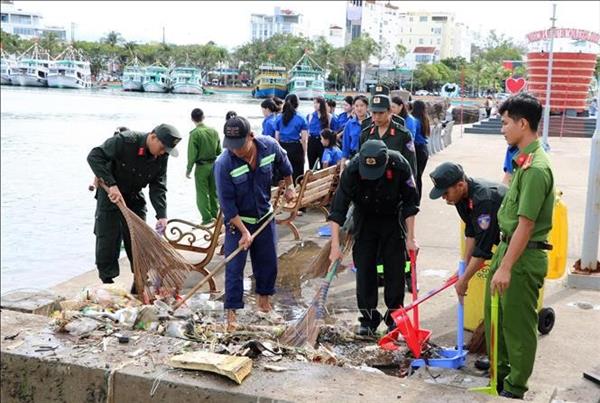The central province of Quang Ngai has allocated funds of 42 billion VND (1.83 million USD) to support ecosystem recovery and biodiversity supervision as well as strengthening the protection of the Ly Son Marine Protected Area (MPA) for the 2018-22 period.
The province said the funds will be used to rebuild coral reefs and sea weed and aquatic species, raise awareness among community members of the need for marine protection and supporting fishermen living in the core zone of strict protected area in the MPA in changing their livelihoods.
The fund will also aim to conserve over-exploited unique seafood products including abalone, holothurian, giant clam and pearl that are threatened with extinction.
The Ly Son MPA, in the waters off Ly Son Island, 30km off the coast of Quang Ngai province, is the remains of eruptions from a dormant volcano. The terrain of the island was structured from volcanoes millions of years ago, leaving landscapes with rocks, caves, cliffs, rock arches and a lake.
However, the rapid development of resorts, hotels and entertainment projects in the Island threaten to seriously damage the ancient geography and ecology of the area.
The islands and a vast coastal area in districts of Binh Son, Tra Bong, Ba To, Sa Huynh, Nghia Hanh and Quang Ngai city on a total of 2,000sq.km are being considered for designation as a Global Geo-Park by UNESCO.
According to head of the Ly Son MPA management board Phung Dinh Toan, the Ly Son MPA was one of 16 nationwide MPAs approved by the Prime Minister in a Master Plan to 2020.
He said the MPA, which covers more than 7,900ha including 7,113ha of sea water, was home to 700 marine fauna species (coral reefs, fish, seaweed and crustaceans), of which 25 were endangered or in danger of extinction.
Toan said more than 400ha of land on the island had been seriously eroded by rising sea levels in the past 40 years.
The Island, where 18 hotel projects and 56 home-stay services were developed in the past few decades, hosts around 200,000 tourists each year.
Ly Son Island, known as the kingdom of garlic in Vietnam, has around 21,000 inhabitants, of whom 73 percent make their living from farming garlic and spring onions, alongside fishing.
The province said the funds will be used to rebuild coral reefs and sea weed and aquatic species, raise awareness among community members of the need for marine protection and supporting fishermen living in the core zone of strict protected area in the MPA in changing their livelihoods.
The fund will also aim to conserve over-exploited unique seafood products including abalone, holothurian, giant clam and pearl that are threatened with extinction.
The Ly Son MPA, in the waters off Ly Son Island, 30km off the coast of Quang Ngai province, is the remains of eruptions from a dormant volcano. The terrain of the island was structured from volcanoes millions of years ago, leaving landscapes with rocks, caves, cliffs, rock arches and a lake.
However, the rapid development of resorts, hotels and entertainment projects in the Island threaten to seriously damage the ancient geography and ecology of the area.
The islands and a vast coastal area in districts of Binh Son, Tra Bong, Ba To, Sa Huynh, Nghia Hanh and Quang Ngai city on a total of 2,000sq.km are being considered for designation as a Global Geo-Park by UNESCO.
According to head of the Ly Son MPA management board Phung Dinh Toan, the Ly Son MPA was one of 16 nationwide MPAs approved by the Prime Minister in a Master Plan to 2020.
He said the MPA, which covers more than 7,900ha including 7,113ha of sea water, was home to 700 marine fauna species (coral reefs, fish, seaweed and crustaceans), of which 25 were endangered or in danger of extinction.
Toan said more than 400ha of land on the island had been seriously eroded by rising sea levels in the past 40 years.
The Island, where 18 hotel projects and 56 home-stay services were developed in the past few decades, hosts around 200,000 tourists each year.
Ly Son Island, known as the kingdom of garlic in Vietnam, has around 21,000 inhabitants, of whom 73 percent make their living from farming garlic and spring onions, alongside fishing.
VNA/VNP


















